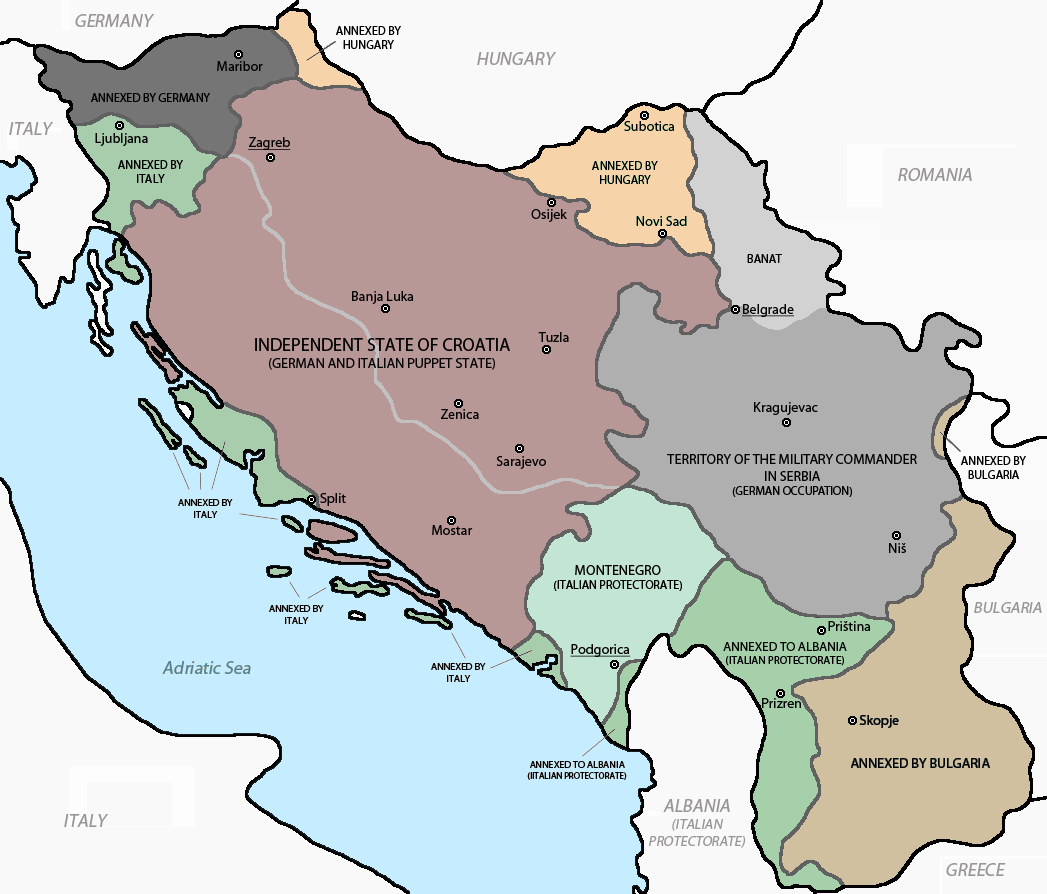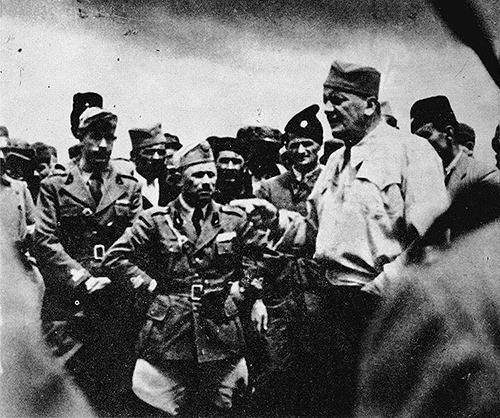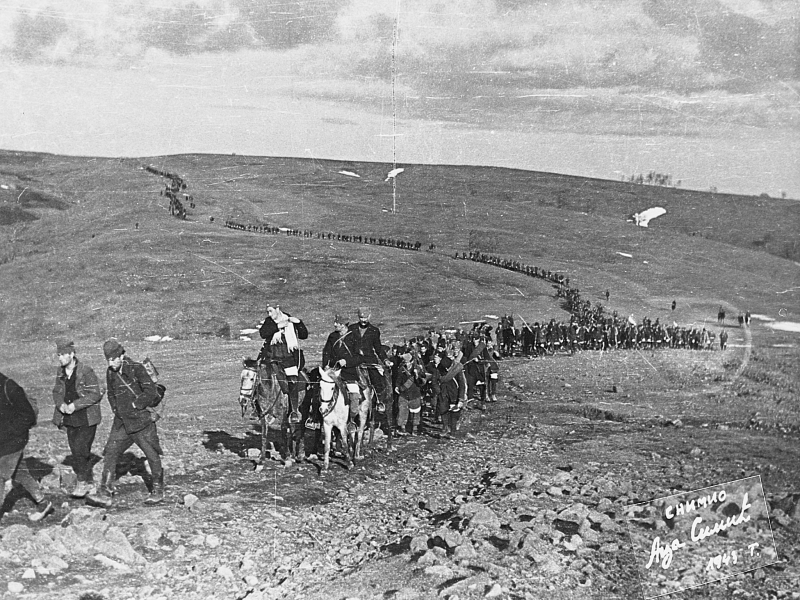|
Chetnik
The Chetniks ( sh-Cyrl-Latn, Четници, Četnici, ; sl, Četniki), formally the Chetnik Detachments of the Yugoslav Army, and also the Yugoslav Army in the Homeland and the Ravna Gora Movement, was a Yugoslav royalist and Serbian nationalist movement and guerrilla force in Axis-occupied Yugoslavia. Although it was not a homogeneous movement, it was led by Draža Mihailović. While it was anti-Axis in its long-term goals and engaged in marginal resistance activities for limited periods, it also engaged in tactical or selective collaboration with the occupying forces for almost all of the war. The Chetnik movement adopted a policy of collaboration with regard to the Axis, and engaged in cooperation to one degree or another by establishing '' modus vivendi'' or operating as "legalised" auxiliary forces under Axis control. Over a period of time, and in different parts of the country, the movement was progressively drawn into collaboration agreements: first with the puppet Gov ... [...More Info...] [...Related Items...] OR: [Wikipedia] [Google] [Baidu] |
Draža Mihailović
Dragoljub "Draža" Mihailović ( sr-Cyrl, Драгољуб Дража Михаиловић; 27 April 1893 – 17 July 1946) was a Yugoslavs, Yugoslav Serb general during World War II. He was the leader of the Chetniks, Chetnik Detachments of the Yugoslav Army (Chetniks), a royalist and nationalist movement and guerrilla force established following the Invasion of Yugoslavia, German invasion of Yugoslavia in 1941. Born in Ivanjica and raised in Belgrade, Mihailović fought in the Balkan Wars and the First World War with distinction. After the fall of Kingdom of Yugoslavia, Yugoslavia in April 1941, Mihailović organized the Chetniks at Ravna Gora (highland), Ravna Gora and engaged in guerrilla warfare alongside Josip Broz Tito's Yugoslav Partisans, Partisans against occupying German forces. Opposing strategies, ideological differences and general distrust drove them apart, and by late 1941 the two groups were in open conflict. Many Chetnik groups Collaborationism, collaborat ... [...More Info...] [...Related Items...] OR: [Wikipedia] [Google] [Baidu] |
Pavle Đurišić
Pavle Đurišić ( sr-cyr, Павле Ђуришић, ; 9 July 1909 – April 1945) was a Montenegrin Serb regular officer of the Royal Yugoslav Army who became a Chetnik commander ('' vojvoda'') and led a significant proportion of the Chetniks in Montenegro during World War II. He distinguished himself and became one of the main commanders during the popular uprising against the Italians in Montenegro in July 1941, but later collaborated with the Italians in actions against the Communist-led Yugoslav Partisans. In 1943, his troops carried out several massacres against the Muslim population of Bosnia, Herzegovina and the Sandžak, and participated in the anti-Partisan Case White offensive alongside Italian forces. Đurišić was captured by the Germans in May 1943, escaped and was recaptured. After the capitulation of Italy, the Germans released Đurišić and he began collaborating with them and the Serbian puppet government. In 1944, he created the Montenegrin Volunteer Corps ... [...More Info...] [...Related Items...] OR: [Wikipedia] [Google] [Baidu] |
Momčilo Đujić
Momčilo Đujić ( sh-Cyrl, Момчилo Ђујић, ; 27 February 1907 – 11 September 1999) was a Serbian Orthodox Church, Serbian Orthodox priest and Chetnik . He led a significant proportion of the Chetniks within the northern Dalmatia and western Bosnia (region), Bosnia regions of the Independent State of Croatia (NDH), a German-occupied Europe, fascist puppet state created from parts of the occupied Kingdom of Yugoslavia during World War II. In this role he Collaboration with the Axis Powers during World War II, collaborated extensively with the Italian and then the German occupying forces against the Communist Party of Yugoslavia, communist-led Yugoslav Partisans, Partisan insurgency. Đujić was ordained as a priest in 1933 and gained a reputation as something of a firebrand in the pulpit. After the assassination of Alexander I of Yugoslavia, King Alexander of Yugoslavia in 1934, he joined the Chetniks in the interwar period, Chetnik Association of Kosta Pećana ... [...More Info...] [...Related Items...] OR: [Wikipedia] [Google] [Baidu] |
Petar Baćović
Petar Baćović ( sh-Cyrl, Петар Баћовић; 1898 – April 1945) was a Bosnian Serb Chetnik commander ( sh-Latn, vojvoda, sh-Cyrl, војвода) within occupied Yugoslavia during World War II. From the summer of 1941 until April 1942, he headed the cabinet of the Ministry of Internal Affairs for Milan Nedić's puppet Government of National Salvation in the German-occupied territory of Serbia. In May and June 1942, Baćović participated in the joint Italian-Chetnik offensive against the Yugoslav Partisans in Montenegro In July 1942, Baćović was appointed by the Chetnik leader Draža Mihailović and his Supreme Command as the commander of the Chetnik units in the regions of eastern Bosnia and Herzegovina within the Axis puppet state, the Independent State of Croatia ( hr, Nezavisna Država Hrvatska, NDH). In this role, Baćović continued collaborating with the Italians against the Yugoslav Partisans, with his Chetniks formally recognised as Italian auxiliaries ... [...More Info...] [...Related Items...] OR: [Wikipedia] [Google] [Baidu] |
Jezdimir Dangić
Jezdimir Dangić (; 4 May 1897 – 22 August 1947) was a Yugoslav and Bosnian Serb Chetnik commander during World War II. He was born in the town of Bratunac in the Austro-Hungarian occupied Bosnia Vilayet of the Ottoman Empire. Imprisoned during World War I for his membership of the revolutionary movement Young Bosnia, he subsequently completed a law degree and became an officer in the gendarmerie of the Kingdom of Serbs, Croats and Slovenes at the beginning of 1928. In 1929, the country changed its name to the Kingdom of Yugoslavia. In 1940, Dangić was appointed to lead the court gendarmerie detachment stationed at the royal palace in the capital, Belgrade. During the Axis invasion of Yugoslavia in 1941, Dangić commanded the gendarmerie unit that escorted King Peter II to Montenegro as he fled the country. In August of that year, the leader of the Chetnik movement, Colonel Draža Mihailović, appointed Dangić as the commander of the Chetnik forces in eastern B ... [...More Info...] [...Related Items...] OR: [Wikipedia] [Google] [Baidu] |
Dobroslav Jevđević
Dobroslav Jevđević ( sr-Cyrl, Доброслав Јевђевић, ; 28 December 1895 – October 1962) was a Bosnian Serb politician and self-appointed Chetnik commander (, војвода) in the Herzegovina region of the Axis-occupied Kingdom of Yugoslavia during World War II. He was a member of the interwar Chetnik Association and the Organisation of Yugoslav Nationalists, a Yugoslav National Party member of the National Assembly, and a leader of the opposition to King Alexander between 1929 and 1934. The following year, he became the propaganda chief for the Yugoslav government. Following the Axis invasion of Yugoslavia in April 1941, he became a Chetnik leader in Herzegovina and joined the Chetnik movement of Draža Mihailović. Jevđević collaborated with the Italians and later the Germans in actions against the Yugoslav Partisans. Although Jevđević recognised the authority of Mihailović, who was aware of and approved of his collaboration with Axis forces, a num ... [...More Info...] [...Related Items...] OR: [Wikipedia] [Google] [Baidu] |
Zaharije Ostojić
Lieutenant Colonel Zaharije Ostojić ( sr-cyr, Захарије Остојић; 1907 – April 1945) was a Montenegrin Serb and Yugoslav military officer who served as the chief of the operational, organisational and intelligence branches of the Chetnik Supreme Command led by Draža Mihailović in Yugoslavia during World War II. He was a major in the Royal Yugoslav Army Air Force prior to the Axis invasion of Yugoslavia, and was involved in the coup that deposed Prince Paul of Yugoslavia on 27 March 1941. After the coup, he escorted Prince Paul to exile in Greece, and was in Cairo during the invasion in April. In September 1941, he was landed on the coast of the Italian governorate of Montenegro along with the British Special Operations Executive officer Captain Bill Hudson and two companions. He escorted Hudson to the German-occupied territory of Serbia and introduced him to the Yugoslav Partisan leader Josip Broz Tito at Užice, then accompanied Hudson to Ravna Gora to m ... [...More Info...] [...Related Items...] OR: [Wikipedia] [Google] [Baidu] |
World War II In Yugoslavia
World War II in the Kingdom of Yugoslavia began on 6 April 1941, when the country was swiftly conquered by Axis forces and partitioned between Germany, Italy, Hungary, Bulgaria and their client regimes. Shortly after Germany attacked the USSR on 22 June 1941, the communist-led republican Yugoslav Partisans, on orders from Moscow, launched a guerrilla liberation war fighting against the Axis forces and their locally established Puppet state, puppet regimes, including the Axis-allied Independent State of Croatia (NDH) and the Government of National Salvation in the Territory of the Military Commander in Serbia, German-occupied territory of Serbia. This was dubbed the National Liberation War and Socialist Revolution in post-war Yugoslav communist historiography. Simultaneously, a multi-side civil war was waged between the Yugoslav communist Partisans, the Serbian royalist Chetniks, the Axis-allied Croatian Ustaše and Croatian Home Guard (World War II), Home Guard, Serbian Volun ... [...More Info...] [...Related Items...] OR: [Wikipedia] [Google] [Baidu] |
Dragutin Keserović
Dragutin Keserović (Serbian Cyrillic: Драгутин Кесеровић; 21 November 1896 – 17 August 1945) was a Yugoslav Chetnik military commander holding the rank of lieutenant colonel and '' vojvoda'' during World War II. Keserović was probably the most active commander of Mihailović's Chetniks in Serbia. Biography 1941 Immediately after the Axis invasion of Yugoslavia in April 1941, then-Major Keserović joined the Pećanac Chetniks under the command of Kosta Pećanac, a World War I ''voivode''. In August, Pećanac concluded a collaborationist agreement with the Germans. Keserović then transferred to the Chetniks of Draža Mihailović. Representatives of the Chetniks held meetings with representatives of the communist Partisan forces in the village of Bovan and made a plan to attack Kruševac. According to this plan, it was agreed that the date of the attack would be 23 September 1941, that Kruševac would be blocked before the attack, that Keserović and his ... [...More Info...] [...Related Items...] OR: [Wikipedia] [Google] [Baidu] |
Vojislav Lukačević
Vojislav Lukačević ( sr-cyr, Војислав Лукачевић; 1908 – 14 August 1945) was a Serbian Chetnik commander in the Kingdom of Yugoslavia during World War II. At the outbreak of war, he held the rank of Captain (armed forces), captain of the Military reserve force, reserves in the Royal Yugoslav Army. When the Axis powers invasion of Yugoslavia, invaded Yugoslavia in April 1941, Lukačević became a leader of Chetniks in the Sandžak region and joined the movement of Draža Mihailović. While the Chetniks were an anti-Axis movement in their long-range goals and did engage in marginal resistance activities for limited periods, they also pursued almost throughout the war a tactical or selective Collaborationism, collaboration with the occupation authorities against the Yugoslav Partisans. They engaged in cooperation with the Axis powers to one degree or another by establishing ''modus vivendi, modi vivendi'' or operating as auxiliary forces under Axis control. ... [...More Info...] [...Related Items...] OR: [Wikipedia] [Google] [Baidu] |
Yugoslav Partisans
The Yugoslav Partisans,Serbo-Croatian, Macedonian, Slovene: , or the National Liberation Army, sh-Latn-Cyrl, Narodnooslobodilačka vojska (NOV), Народноослободилачка војска (НОВ); mk, Народноослободителна војска (НОВ); sl, Narodnoosvobodilna vojska (NOV) officially the National Liberation Army and Partisan Detachments of Yugoslavia, sh-Latn-Cyrl, Narodnooslobodilačka vojska i partizanski odredi Jugoslavije (NOV i POJ), Народноослободилачка војска и партизански одреди Југославије (НОВ и ПОЈ); mk, Народноослободителна војска и партизански одреди на Југославија (НОВ и ПОЈ); sl, Narodnoosvobodilna vojska in partizanski odredi Jugoslavije (NOV in POJ) was the communist-led anti-fascist resistance to the Axis powers (chiefly Germany) in occupied Yugoslavia during World War II. Led by Josip Broz T ... [...More Info...] [...Related Items...] OR: [Wikipedia] [Google] [Baidu] |
Predrag Raković
Predrag Raković ( sh-Cyrl, Предраг Раковић; 10 June 191215 December 1944) was a Yugoslav military officer who joined the Chetnik forces of Draža Mihailović after the Axis invasion of Yugoslavia in April 1941 during World War II. He became commander of the Chetnik 2nd Ravna Gora Corps and collaborated with the German-installed puppet government in the German-occupied territory of Serbia and later directly with the Germans against the rival communist-led Yugoslav Partisans. His forces briefly cooperated with Soviet forces against the Germans in October 1944, but faced with Soviet demands that they lay down their weapons or join the Partisans, they withdrew from occupied Serbia. Early life and career Predrag Raković was born on 10 June 1912 in the village of Prijevor, near Čačak in the Kingdom of Serbia. He was one of five sons of Milosav and Milorada Raković. Serbia became part of the Kingdom of Serbs, Croats and Slovenes (Yugoslavia from 1929) in 1918. When he c ... [...More Info...] [...Related Items...] OR: [Wikipedia] [Google] [Baidu] |








.jpg)